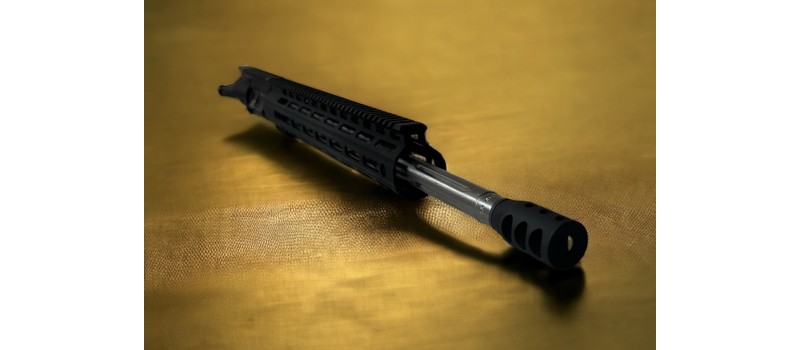When it comes to building a high-quality AR rifle, one of the key decisions you'll need to make is whether to go with a carbine gas system or a pistol gas system for your 16" barrel 300 blackout (300 blk upper). Understanding the differences between these two options and how they can impact the performance of your rifle is crucial for making an informed decision. In this guide, we'll break down the pros and cons of both gas systems to help you choose the right one for your needs.
Understanding the 300 Blackout Cartridge and Its Versatility
The 300 blackout cartridge stands out in the firearms community for its remarkable adaptability and efficiency. Originally designed to achieve optimal performance from the AR platform with a minimal change to the standard magazine and bolt, it excels in versatility. The ability to shoot both supersonic and subsonic ammunition without requiring a change in gas system or bolt is a significant advantage. This dual compatibility allows for a seamless transition between uses, such as quiet, covert operations with subsonic rounds or more traditional, louder shooting scenarios using supersonic rounds. Its design caters to a broad spectrum of shooting disciplines, from precision shooting and hunting to home defense and tactical applications. The 300 blackout's ability to deliver considerable energy on target, especially at close to intermediate ranges, while maintaining a manageable recoil, further underscores its practicality across various shooting needs. This cartridge's design philosophy emphasizes maximizing the AR-15 platform's potential, bridging the gap between the 5.56mm round's high velocity and the .45 ACP's stopping power, thus offering a comprehensive solution for shooters looking for versatility without compromise.
What Is a Gas System and Why It Matters
A gas system in an AR rifle is a critical component that harnesses the energy from a fired cartridge to automatically cycle the gun's action, ejecting the spent casing and chambering a new round. It does so by diverting a portion of the propellant gases through a small hole in the barrel, using this pressure to operate the mechanism. The choice between a carbine and a pistol gas system is pivotal as it directly influences the rifle's reliability, cycling speed, and recoil management. Opting for the correct system affects not just the operational efficiency but also the shooter's comfort and the firearm's longevity. Without a well-tuned gas system, a rifle may underperform, experience malfunctions, or exhibit increased wear and tear over time. Hence, understanding the nuances of each option is fundamental for anyone looking to optimize their AR platform for specific needs, whether it's for competitive shooting, hunting, or tactical purposes.
Carbine Gas System: Pros and Cons for 16" Barrel 300BLK
The carbine gas system is often selected for its reliability and consistency, particularly with 16" barrel 300 blackout uppers. Its design ensures a stable gas flow, which is crucial for the smooth operation of the AR rifle, potentially enhancing its performance. This choice benefits shooters who prioritize a rifle's dependable cycling under various conditions. On the flip side, the carbine gas system might introduce a more pronounced felt recoil. This increase in recoil is due to the longer gas tube, which can affect the shooting experience by making the firearm more challenging to control, especially for rapid follow-up shots or during extended shooting sessions. Additionally, while the carbine system is well-regarded for its efficiency, it may not be the optimal choice for those seeking the softest shooting experience possible. It's worth noting that personal preference plays a significant role in this decision, as what one shooter considers a drawback, another may view as inconsequential compared to the system's reliability.
Pistol Gas System: Pros and Cons for 16" Barrel 300BLK
Opting for a pistol gas system on a 16" barrel 300 blackout upper introduces a nuanced balance between performance and wear. The primary advantage lies in the system's ability to offer a noticeably smoother recoil, which is especially appreciated by those who prioritize comfort and control during shooting. This reduced recoil can lead to improved accuracy and a more enjoyable shooting experience, particularly for those engaged in activities requiring quick, successive shots. Another benefit is the potential for a slightly faster cycling rate, which may be advantageous in competitive or tactical situations where every second counts.
However, this choice is not without its drawbacks. The shorter gas system places more stress on certain rifle components, accelerating wear and potentially necessitating more frequent maintenance or parts replacement. This increased strain can affect long-term reliability and durability, raising considerations about the rifle's lifespan and overall cost-effectiveness. Additionally, the pistol gas system's compatibility with the wide array of 300 blackout ammunition types must be carefully considered, as it may not handle the spectrum of supersonic and subsonic rounds as effectively as its carbine counterpart, potentially limiting its versatility in various shooting scenarios.
Customization Options and Availability for Both Systems
The versatility of the 300 blackout upper is further enhanced by the wealth of customization options available for both carbine and pistol gas systems. Shooters can choose from a plethora of handguard lengths, muzzle devices, and gas block types to tailor their rifle to their specific needs and shooting style. While both systems offer significant flexibility, it's important to research and understand the compatibility of certain aftermarket parts with your chosen gas system. Some accessories might be more readily available for one system over the other, potentially influencing your decision. Manufacturers and aftermarket suppliers often cater to the preferences and demands of the shooting community, so availability can vary based on current trends and innovations in firearm technology. Exploring these customization options not only allows for a more personalized shooting experience but also ensures that your rifle is equipped to meet the demands of your shooting endeavors, whether they be competitive shooting, hunting, or tactical applications.
Cost Considerations: Getting the Best Bang for Your Buck
When it comes to outfitting your AR with either a carbine or pistol gas system, especially for a 16" barrel 300 blackout upper, initial price tags and future expenses play pivotal roles in decision-making. The pistol gas system often carries a heftier upfront cost due to its specialized design and perceived benefits in recoil management and shooting comfort. However, it's vital to delve beyond purchase prices and consider the maintenance landscape. The accelerated wear on components associated with the shorter gas system of the pistol variant may necessitate more frequent repairs or replacements, potentially elevating long-term costs. Conversely, the carbine gas system, while possibly less expensive initially, offers a balance of reliability and durability that could translate to reduced upkeep expenses over time. Balancing these financial considerations against your performance requirements and shooting habits is essential. Engaging with a nuanced understanding of both systems' cost dynamics will empower you to make a choice that aligns with both your budgetary constraints and your shooting ambitions, ensuring a fulfilling and economically wise investment in your shooting experience.
User Experiences and Real-World Performance
Exploring user feedback and real-world application sheds light on the practical aspects of choosing between carbine and pistol gas systems for a 16" barrel 300 blackout upper. Enthusiasts often share their journey through forums, blogs, and social media, revealing nuanced differences in performance under varied conditions. These anecdotal accounts can provide valuable insights into how each system handles different types of ammunition, the frequency of maintenance required due to wear and tear, and the subjective experience of recoil and control during shooting. Some users highlight the carbine system's reliability and smoother cycling with a broad range of ammo, while others appreciate the pistol system's reduced recoil and quick handling, despite its demands for more attentive maintenance. This firsthand feedback emphasizes the importance of aligning the gas system with one’s shooting style and maintenance commitment, offering a more nuanced understanding of each system's behavior in diverse shooting environments.
Conclusion: Making the Right Choice for Your 300BLK Upper
Deciding between a carbine or pistol gas system for a 16" 300 blackout upper boils down to prioritizing what matters most to you in a firearm. Each system brings its unique set of advantages and potential drawbacks, shaping not only the rifle's immediate performance but also influencing its long-term usability and maintenance needs. If you value smoothness of operation and reduced recoil for quicker, more comfortable follow-up shots, the pistol gas system might align with your shooting preferences. However, if reliability across a wide range of ammunition and conditions, alongside fewer maintenance concerns, is your priority, then the carbine gas system could be the better choice.
Consideration of customization availability, cost implications, and real-world user experiences should also guide your decision. Customization can enhance the shooting experience, but be mindful of compatibility with your chosen system. Financially, upfront costs versus long-term maintenance and potential parts replacement need to be balanced against the performance benefits each system offers.
Engaging with the community and leveraging shared experiences can further inform your decision, providing practical insights beyond technical specifications. Ultimately, your specific shooting goals, preference for recoil management, maintenance commitment, and budget will direct you toward the gas system that best suits your 300 blackout upper's needs, ensuring a rewarding shooting experience.










